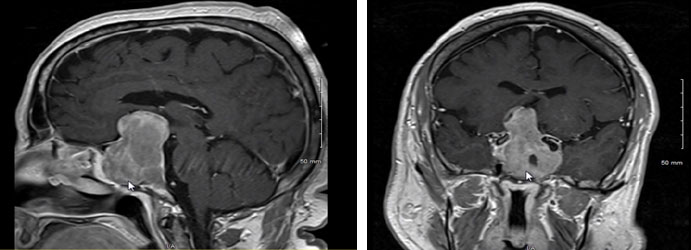Pituitary Tumors
Pituitary tumors generally come to medical attention in one of two ways. In some instances there is visual loss owing to pressure of the pituitary tumor on the optic nerves and the chiasm where the two optic nerves meet. This can lead to permanent blindness if left untreated. The other way these tumors are found relates to hormonal syndromes. This may include unexpected milk production from the breasts, irregular periods or loss of menstrual function, erectile dysfunction, abnormal growth of the chin and hands with coarsening of facial features (called acromegaly), or symptoms of hyperthyroidism. In these tumors, the abnormal pituitary tumor cells may be producing unwanted hormones. In either of these situations, surgery may be necessary.
A type of hormone-secreting pituitary tumor called a prolactinoma produces the hormone prolactin. The symptoms of breast milk production, loss of periods, or impotence in males can sometimes be reversed by being on a medication called bromocriptine. This shrinks the cells but only while the patient continues to take the medication. If the patient stops, the tumor cells rapidly enlarge and often can cause hemorrhage in the pituitary which can be a surgical emergency.
Some pituitary tumors are small and can be removed through the nose either using an endoscope or a surgical microscope. The technical results are the same, although each has its own advantages and disadvantages. Other large tumors that extend asymmetrically above the level of the optic nerves are frequently more safely approached through a craniotomy like other brain tumors.
The example below shows a very large pituitary tumor.

The arrows in each picture point to the bottom of the tumor which is in the sphenoid air sinus. The large white mass extends up pushing the optic apparatus. The dome of the tumor deforms the ventricular system of the brain and invaginates far into the third ventricle. This is the type of tumor that might be treated in stages, dealing with the top portion via a craniotomy approach, and doing the bottom through a transnasal transsphenoidal approach. Often these large tumors do not secrete hormones. The normal pituitary gland is compressed around the tumor but may still be functional.
The video below shows the view by a transcranial approach from the left side with the sugical instrument pointing to the left and right optic nerves, with tumor below them extending above the optic apparatus and pushing deep into the brain.

 Hablamos Español
Hablamos Español